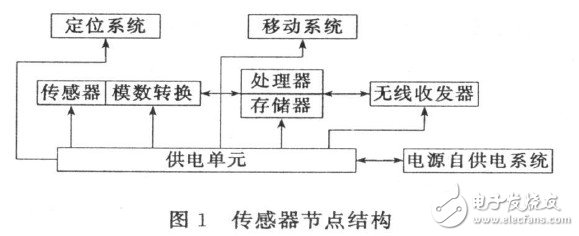With the rapid development and maturity of Micro Electro-Mechanical Systems (MEMS), low-power radio communication technology, embedded computing technology, micro-sensor technology and integrated circuit technology, a large number of low-cost, low-power consumption The small-capacity, short-range communication multi-function miniature sensor is self-organized into a wireless sensor network (WSN) through a wireless link. WSN has been widely used in military, transportation, environmental monitoring and forecasting, health care, space exploration and other fields. At present, it has attracted much attention in the international arena, and many research hotspots have emerged. 1 Node structure of wireless sensor network The basic components and functions of the sensor node include the following units: sensing unit, processing unit, wireless communication unit and power supply unit, as shown in Figure 1. In addition, other optional functions include positioning systems, mobile systems, and power supply systems. The sensor unit is composed of a sensor and a digital-to-analog conversion module for sensing and acquiring information in the monitoring area and converting it into a digital signal. The processing unit is composed of an embedded system, including a processor, a memory, etc., and is responsible for control and coordination. The operation of each part of the node, storing and processing the data collected by itself and the data sent by other nodes; the wireless communication unit is composed of a wireless communication module, which is responsible for communicating with other sensor nodes, exchanging control information and transmitting and receiving data; A miniature battery that provides the sensor node with the energy it needs to function properly. 2 Characteristics of wireless sensor networks People once thought that mature Ad-hoc network mechanisms and technologies can be applied to wireless sensor networks. However, with in-depth research, the technical requirements and application goals of wireless sensor networks are significantly different from those of Ad-hoc networks. The Ad-ho c network is committed to providing users with high-quality data transmission services for the purpose of transmitting data. Wireless sensor networks are the primary design goal for efficient use of energy, and are data-centric. Wireless sensor networks have many unique features that distinguish them from Ad-hoc networks. 1 Large scale and high density. Unlike Ad-ho c networks, wireless sensor networks are often deployed in large areas of monitoring. In order to obtain more accurate and complete information, it is necessary to deploy large-scale, high-density sensor nodes in order to achieve synergy through a large number of redundant nodes. Work to improve the quality of the system's work. 2 is data-centric. In a wireless sensor network, the end user does not specifically care about the monitoring data of a single node, and usually only cares about the value of a certain monitoring indicator in a certain area. 3 poor reliability. Wireless sensor network nodes are much more likely to fail than Ad-hoc networks. Sensor nodes are deployed in a designated harsh environment or unmanned area by random broadcast. Working in an unattended state, network maintenance becomes very difficult. 4 sensor nodes have limited capabilities. The energy, processing, storage, and communication capabilities of sensor nodes are very limited. 5 Relevant to the application. Wireless sensor networks acquire information from the outside world by perceiving the objective world. Because different applications care different information, wireless sensor networks can only carry out design work for each specific application, and cannot have a unified communication protocol platform like the Internet. Due to different applications, wireless sensor networks have different requirements for network systems, and hardware platforms, software systems, and communication protocols vary greatly. 6 dynamic changes quickly. Wireless sensor networks generally work in harsh environments. Changing external environments, such as unexpected events, exhaustion of node energy, and disconnection of wireless communication links, can seriously affect system functions. This requires sensor nodes to adjust themselves. The working state and the topology of the network to adapt to changes in the environment.
Description of Stacked D-Sub I/O Connectors
Range of of Stacked D-Sub I/O Connectors
Stacked D-Sub I/O Connectors Dual Port (Stacked) D Sub,,Stacked D Sub I/O Connectors,Dual-Port Stacked D-Sub Connectors,Male Stacked D sub Connector, Female Stacked D sub Connector, Standard Stacked D sub Connector, High Density Stacked D sub Connector ShenZhen Antenk Electronics Co,Ltd , https://www.antenk.com
Antenk's connectors are designed for applications requiring multiple connector ports with limited PCB space
The condensed footprint of Antenk's dual port D-sub solution is available in four industry sizes, three connector spacing options, and six hardware configurations for one of the broadest stacked D-sub offerings on the market in standard and high-density variations.
Stacked D-sub I/O Connectors are designed for applications requiring multiple connector ports with limited PCB space. Two right angle D-sub connectors are stacked one on top of another, creating a single dual-port connector with a very condensed footprint.
Features of Stacked D-Sub I/O Connectors
Available in four industry standard sizes:
Standard Density : 9, 15, 25, 37
Available in three connector spacing options: 0.625", 0.750", 0.900"
Available in six hardware configurations
High-temperature UL94 V-0 thermoplastic (260°C process temp)
High performance stamped contacts
Applications of Stacked D-Sub I/O Connectors
Communications
Instrumentation
Medical
Computers/peripherals
Commercial industry
Test labs
Gaming industry
Standard Density Stacked D sub Connector
High Density Stacked D sub Connector
Dual-Port Stacked D-Sub Connectors